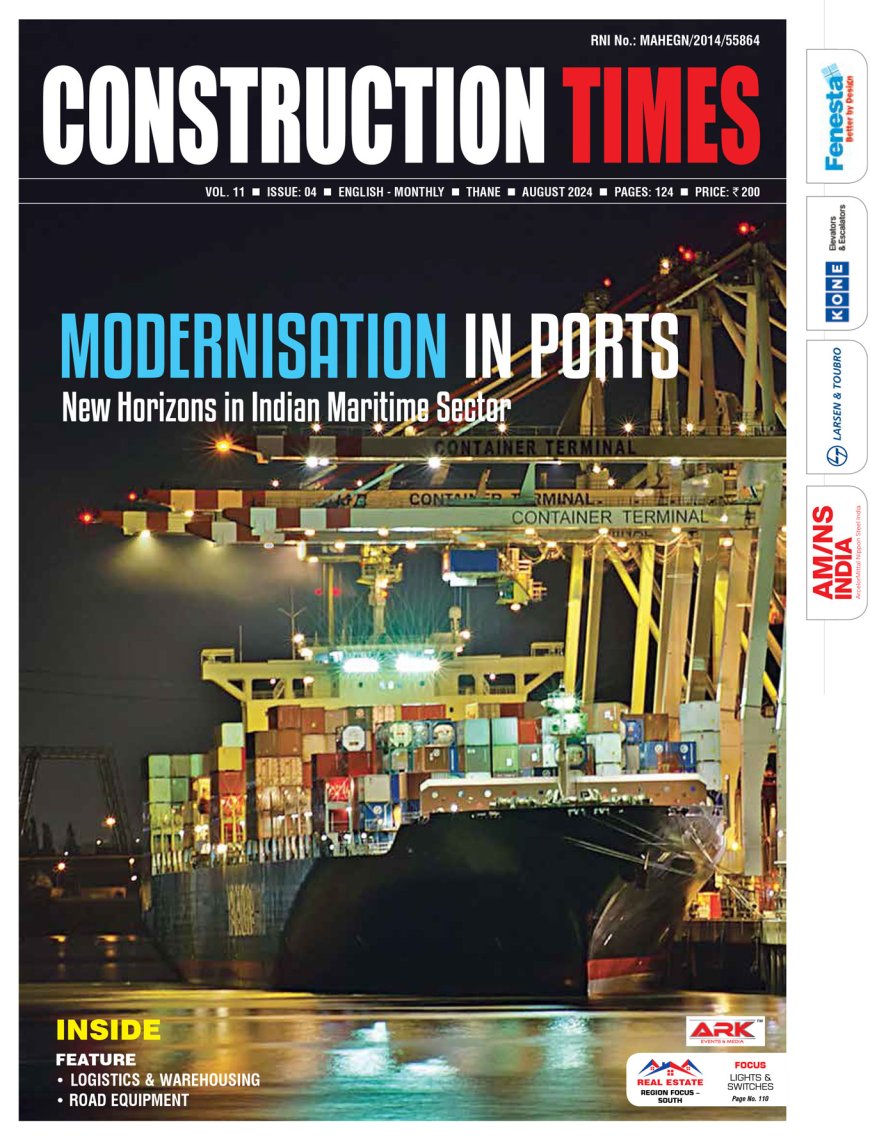Indian ports are already competing with global ports in several parameters.

Varun Gogia,
Assistant Vice President & Sector Head - Corporate Ratings, ICRA Limited
How do you view the performance of Indian ports sector last year? How are you experiencing the progress this year?
Indian port sector continued to witness stable performance with overall cargo volume growing by ~7.5% YoY in FY2024. The volume growth was underpinned by a robust container volume growth of ~11% yoy followed by the growth of 8.7% yoy in the coal cargo volumes handled at the ports. The other segments like iron ore witnessed a 36% yoy surge followed by Petroleum Products (POL) which witnessed a 3.5% yoy growth. The container volumes grew owing to the rising containerization of the cargo in the country. The coal volume growth was driven by a directive by GoI for blending imported coal to meet the rising demand for power, particularly in the summer and monsoon seasons. The iron ore volumes handled at the ports surged owing to strong demand from China and also the base effect of FY2023 wherein export duty levied on the export of iron ore had led to lower exports.
In the current financial year so far, i.e. Q1 FY2025, overall cargo volumes have witnessed a tepid growth of 4% yoy. The growth has been largely backed by a 15% yoy growth in the container cargo volumes and a 6% yoy growth in the POL volumes handled at the ports. The growth in these two segments was partially offset by lower fertilizer (-15% yoy) and iron ore volumes (-10% yoy) while the coal volumes were largely unchanged yoy.
ICRA expects the port volumes to witness a growth of around 6-8% yoy in FY2025, driven largely by the container segment and modest growth in the coal and petroleum products volumes. The iron ore volumes are expected to moderate in the current fiscal post a sharp rise in exports in FY2024 amid weak demand for steel in China.
What is your overview of Indian ports improving their performance on a global level?
Indian ports have invested significantly in efficiency improvement initiatives in the recent past and the investments are expected to continue under the Sagrmala programme going forward. Under the Sagarmala initiative, nearly Rs 32,066 crores has already been invested in port modernization projects till March 2024 whereas another Rs 75,650 crore worth of projects are under various stages of implementation. These projects focus on capacity enhancement at major ports as well as efficiency improvement. Additionally, GoI has also invested in improving port connectivity to the hinterlands through improvement in rail and road connectivity, which has resulted in faster evacuation of the arriving cargo from the ports.
As per the Logistics Performance Index (LPI) report published by the World Bank, India’s LPI rank improved to 38 in CY2023 vis-à-vis 44 in CY2018. The country witnessed an improvement across most of the parameters evaluated under the study over the course of 2018 to 2023. The most notable improvement can be witnessed across the parameters of infrastructure and logistics competence and quality which has resulted in improvement in timeliness as well as the ability to offer competitively priced international shipments. Over the past few years, significant investments have been undertaken in improving port infrastructure by the GoI as well as the private sector. The logistics sector has also witnessed heightened investment activity in terms of expansion of warehousing capacity, with rail as well as road logistics infrastructure development being the most notable developments. The large investments being undertaken in the development of deep draft seaports at Vizhinjam and Vadhawan port along with significant capacity additions at other ports, will further enable the Indian ports to accommodate ever-increasing vessel sizes going forward. Additionally, with increasing digitization measures underway across the logistics value chain in the country along with the mechanization of port operations, Indian ports are becoming more efficient and closing the gap with their global counterparts.
How is containerization growing at Indian ports and maritime trade? What are the current challenges in container handling?
The overall containerized cargo volumes handled at the Indian ports have witnessed a healthy CAGR of 6.8% over the course of FY2011 to FY2024. The rising containerization of the cargo in the country and improving container handling infrastructure in the country are contributing largely to the rising container volumes handled at the Indian ports. Over the last couple of years with the focus of GoI on bringing the overall logistics costs down as a percentage of Gross Domestic Product (GDP), significant infrastructure development has happened in terms of container handling capacity at the ports as well as in the hinterland and the modes connecting the hinterland and the ports i.e. rail and road logistics. The natural advantages of using containerized cargo movement include reduced instances of theft/pilferage/damage and faster turnaround times owing to handling of standardized cargo have resulted in increasing adoption. The improved connectivity of the Indian ports with the global liner shipping network as measured by the Liner Shipping Connectivity Index (LSCI) has also contributed to the rising container volumes at the ports. The share of containerized cargo handled at Indian ports has risen from around 15% in FY2011 to around 21% in FY2024 with increasing adoption of containerization of cargoes. Over the years, there have been various experiments for containerized movement of cargo which earlier used to move through other means, e.g. cement, hot rolled coils (HRC), steel coils etc.
While containerization has witnessed healthy growth in India, there are several challenges that remain. Several ports in the country which are major container handling hubs continue to face congestion issues either due to capacity constraints at the port level or limited evacuation infrastructure from the ports resulting in higher turn-around time for vessels. While the GoI had brought about the Direct Port Delivery (DPD) model to reduce the congestion at ports as well as reducing the dependence on Custom Freight Stations (CFS), the same has seen limited adoption. Additionally, the hinterland connectivity to the ports still remains a work in progress, although the commissioning of the Dedicated Freight Corridors (DFCs) has provided some relief on the hinterland connectivity part. All these factors translate into higher logistics costs for the end-user and thus need to be resolved as early as possible, to reduce logistics costs through container cargo movement in the country.
How do you foresee new opportunities for transhipment at Indian ports with new deep-water ports coming up?
Currently, around 25% of the total container cargo handled at the Indian ports is transhipped and around 75% of this volume is handled outside the Indian ports. The same results in revenue loss for the Indian ports, longer lead time, and additional logistics costs for the end users. A large share of the transshipment volumes for India are routed through the Colombo port and as a result, a fair share of India’s trade remains exposed to geo-political uncertainties in the country as was witnessed in the early part of CY2022 when the country went into a turmoil.
GoI for long has been looking to reduce its dependence on Colombo port however, the pricing at the Colombo port remains competitive and India lacks deep draft ports that can handle these large-size vessels. Additionally, the propensity of the shipping companies to switch remains low given the hassles pertaining to the documentation which has been established over the years. However, going forward, with the development of the Vizhinjam port a part of the Indian trans-shipped volumes are expected to be handled through the port which should result in lower logistics costs. Vizhinjam which is a deep draft sea-port and is located on the international shipping routes connecting the Strait of Malacca and the Suez Canal thereby connecting the Far East to Europe, can provide significant cost savings and in the long run, also target the international cargo volumes which are currently being handled at the Colombo port. GoI is also looking at developing a transshipment terminal in the Andaman Islan’s Galathea Bay with a total investment of $9 billion, although the project is still in the drawing board stage. However, once the project is commissioned it will provide a strong alternative to other transshipment hubs in the region which are increasingly facing challenges of congestion. All this being said, the new transshipment ports will have to be competitive in terms of pricing as a majority of the transshipment hubs in the region i.e. Jebel Ali, Colombo, and Singapore have been in operation for the last several years and thus offer highly competitive pricing.
What is the contribution of private ports in India’s maritime business?
While GoI has played a major role in the development of the port sector in the past, it has increasingly promoted the Public Private Partnership (PPP) model for furthering the development of the port sector in India. The private sector has been participating in setting up cargo handling terminals at major parts under the PPP model, undertaking brownfield expansions at existing non-major ports, and setting up new greenfield non-major ports as well. GoI under its National Monetisation Plan (NMP) had identified 31 projects on the 12 major ports worth Rs 14,483 crore to be monetized over FY2022 to FY2025 and in FY2025 alone it is expected that close to around Rs 10,000 crore of projects will be tendered out on the major ports, thereby exceeding the initial targets set. In FY2024, the Ministry of Ports, Shipping, & Waterways (MoPSW) monetized assets worth ~Rs 7,627 crore achieving around 70% of its yearly target. The private sector has also shown keen interest in taking up projects being bid out by GoI. Given that the sector remains capital intensive, players with strong balance sheets have been able to expand their operations and have also been able to consolidate their position through acquisitions. As a result, the overall financial health of the sector has also improved. The private sector has also brought in more dynamism in the sector through higher mechanization and efficient operations bringing down overall logistics costs. Additionally, the majority of the private players have developed a presence across the logistics value chain thereby providing end-to-end services to customers.
What is your outlook on Indian ports and their developments on a global level?
Indian port sector has witnessed several reforms over the course of the last few years in terms of pricing freedom for new terminals at Major ports (in line with non-Major ports), removal of Tariff Authority for Major Ports (TAMP) with tariff fixation now to be done by port authorities among others. The same has revived the interest of the private sector in the port sector. As the country moves ahead to achieve higher growth, the port sector along with the back-end logistics sector will continue to play a major role. With several projects underway for capacity expansion as well as efficiency improvement, the Indian ports are already competing with global ports in several parameters. With the completion of these projects, the Indian port sector should witness healthy improvement in performance going forward. On an overall basis, with India expected to grow at a faster pace relative to several other major economies, timely execution of the projects and policy continuity for the sector will remain imperative to support the overall growth of the economy and reduction in logistics costs.















